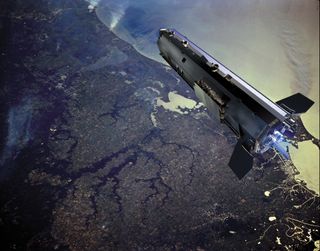Doomed European Satellite May Fall to Earth Tonight, But Where?

Update: The European GOCE satellite re-entered Earth's atmosphere on Sunday (Nov. 10) and burned up during the descent. Read our full story here: 1-ton European Satellite Falls to Earth in Fiery Death Dive
A European satellite at the end of its mission is expected to fall out of space tonight. The only question is where its charred and twisted remains may fall.
According to European Space Agency predictions, the falling GOCE satellite could to Earth sometime Sunday night (Nov. 10) or early Monday. The gravity-mapping spacecraft ran out of fuel in mid-October and has been falling back to Earth ever since.
"The satellite is at an altitude of 147 km (91 miles), dropping at a rate of more than 1 km (0.6 miles) an hour," ESA's GOCE spacecraft operations manager Christoph Steiger wrote in a status update today, adding that the atmospheric drag on the satellite is too high to measure. "Given the fast altitude drop and change of environmental conditions, the end of flight operations is getting close." [6 Biggest Spacecraft to Fall Uncontrolled from Space]
The GOCE spacecraft is about 17 feet (5.3 meters) long and 3.2 feet (1 m) wide. It weighs about 2,425 pounds (1,100 kilograms). ESA scientists expect 25 to 45 fragments of the satellite to survive the fiery re-entry through Earth's atmosphere. The largest could weigh up to 200 pounds (90 kg), according to The New York Times.
Steiger wrote that temperatures at the nose of the sleek satellite keep increasing, but have not reached levels that would prevent GOCE from functioning.
ESA's GOCE satellite successfully completed its gravity-mapping mission earlier this year, and an uncontrolled fall from space was always to be its fate, ESA officials have said.
Get the Space.com Newsletter
Breaking space news, the latest updates on rocket launches, skywatching events and more!
The 350 million euro ($467.8 million) GOCE spacecraft launched in March 2009 to measure the Earth's gravitational field with unprecedented detail, according to an ESA fact sheet. The satellite's name is short for Gravity field and steady-state Ocean Circulation Explorer.
The spacecraft was powered by a Xenon ion engine, which allowed it to fly much lower than typical satellites. ESA officials dubbed to satellite the "Ferrari of Space" because of its sleek, fast design. Just after launch, GOCE flew at altitude of 159 miles (255 km) to measure Earth's gravity field and oceans. By August 2012, it had dipped to an altitude of just 139 miles (224 km).

In 1979, NASA's huge Skylab space station fell to Earth and rained debris over parts of Australia. In September 2011, NASA's defunct Upper Atmospheric Research Satellite dropped debris into the Pacific Ocean. One month later, in October 2011, Germany's ROSAT X-ray space observatory burned up in Earth's atmosphere after 21 years in orbit.
In January 2012, Russia's troubled Phobos-Grunt Mars moon probe fell from space after failing to leave Earth orbit following its launch in November 2011.
Email Tariq Malik at tmalik@space.com or follow him @tariqjmalik and Google+. Follow us @Spacedotcom, Facebook and Google+. Original article on SPACE.com.
Join our Space Forums to keep talking space on the latest missions, night sky and more! And if you have a news tip, correction or comment, let us know at: community@space.com.

Tariq is the Editor-in-Chief of Space.com and joined the team in 2001, first as an intern and staff writer, and later as an editor. He covers human spaceflight, exploration and space science, as well as skywatching and entertainment. He became Space.com's Managing Editor in 2009 and Editor-in-Chief in 2019. Before joining Space.com, Tariq was a staff reporter for The Los Angeles Times covering education and city beats in La Habra, Fullerton and Huntington Beach. In October 2022, Tariq received the Harry Kolcum Award for excellence in space reporting from the National Space Club Florida Committee. He is also an Eagle Scout (yes, he has the Space Exploration merit badge) and went to Space Camp four times as a kid and a fifth time as an adult. He has journalism degrees from the University of Southern California and New York University. You can find Tariq at Space.com and as the co-host to the This Week In Space podcast with space historian Rod Pyle on the TWiT network. To see his latest project, you can follow Tariq on Twitter @tariqjmalik.
